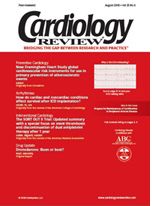Publication
Article
Cardiology Review® Online
Inaugural article for pulmonary arterial hypertension section
In the diabetes section this month, Drs. Tayo A. Addo and Issam Moussa evaluated the impact of sirolimus-eluting stents
on outcome in 279 patients with diabetes
compared with 778 nondiabetic patients. Although the general trend was excellent, patients with diabetes still underwent more repeat interventions. The clinical implications of this study are discussed by Dr. William E. Lawson.
This edition of Cardiology Review unveils a new feature for our journal, with an overview article on pulmonary arterial hypertension inaugurating this topic as a section in its own right. Our initial article by Dr. Girish Reddy discusses the various categories of this complex disease state as defined by the World Health Organization in 2003, as well as current concepts about the syndrome’s pathophysiology, diagnosis, and management options.
Cardiology Review has a fascinating entry this month in the combined lipid disorders and CAD/angina sections on the use of HMG-CoA reductase inhibitors (statins) as part of the early treatment of acute coronary syndromes (ACS). Dr. Shinya Okazaki and associates from Japan enrolled 70 patients in their study, all of whom had percutaneous coronary interventions but only half of whom were randomized to 20 mg of atorvastatin. This treatment was continued for 6 months. Compared with placebo, it significantly reduced intracoronary plaque volume as determined by intravascular ultrasound measurements. Drs. Dipsu D. Patel and Alan G. Wasserman comment on this study, concluding that treatment with a statin is clearly beneficial and should be considered early in all patients with ACS.
In the heart failure section, Dr. Finn Gustafsson and associates from Denmark studied the effect of advanced age as an important factor in predicting mortality in patients with heart failure, as well as how age interacts with left ventricular systolic function. Their population of 5,419 patients yielded several interesting results, and Dr. George I. Mallis assesses their clinical importance in his commentary, concluding that we should be providing optimal treatment to all congestive heart failure patients.
Dr. Brian Olshansky has provided a thoughtful overview article for the arrhythmia section on why rate control in atrial fibrillation may be as good a management strategy as attempting to control the rhythm by conversion to, and maintaining, sinus rhythm. He describes how the NIH-sponsored Atrial Fibrillation Follow-up Investigation of Rhythm Management trial has helped provide a rationale for this approach.
